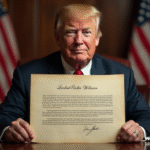Tariffs Multiplied Fivefold: Highest Since 1936
With the new tariffs announced this week by Donald Trump, the average customs duty rate has multiplied by five and will be the highest since 1936, according to Yale University’s Budget Lab.
Minimum Tariff Increase
Since early April, products entering the United States are subject to a minimum tariff rate of 10%, a significant increase from the previous average of 2.5% by the end of 2024.
For about sixty countries, this rate is expected to be even higher. Trump announced tariffs ranging from 11% to 48% on April 2, but suspended them the following day for 90 days to allow for trade negotiations.
Only two agreements have been signed so far, with the United Kingdom and Vietnam. The implementation date, initially set for July 9, was postponed to August 1.
Since Monday, the U.S. President has announced to about a dozen countries, mainly Asian ones, the tariffs he will apply to their goods starting August 1. These range from 20% to 50%, pending further postponement.
The European Union (EU), India, and Taiwan, among others, are yet to learn about the possible tariff increase on their goods.
On Thursday, Donald Trump indicated that future tariffs will impose rates between 15% and 20%.
China, Canada, and Mexico
For China, Canada, and Mexico, the tariffs are not “reciprocal.”
According to Trump, they are imposed to encourage these countries to combat the fentanyl trafficking, a potent opioid causing a severe health crisis in the U.S., and to increase efforts against illegal immigration in Canada’s case.
For Canada and Mexico, the tariffs are 25%, and even 35% for Canada starting August 1, accused by the U.S. President of retaliatory measures.
These tariffs only apply to products not entering the U.S. under the North American Free Trade Agreement (NAFTA), a minority.
Additionally, oil and potash are only taxed at 10%.
For China, the applied rate was initially 20%, then 30% on April 2, with an additional 10% on all products entering the U.S., adding to pre-existing tariffs on various products before Trump’s term.
Both China and the U.S. entered a retaliatory spiral before agreeing to reduce their respective tariffs: China will charge 10%, and the U.S. 30%, at least until mid-August while negotiating a trade deal.
Brazil’s Case
Trump used tariffs as a political weapon against Brazil.
On Wednesday, the South American giant was surprised to learn that its products would be subject to a 50% tariff.
Trump protested against the trial of former far-right President Jair Bolsonaro, accused of attempting a coup. He considers it a “witch hunt.”
Lula warned of possible retaliation.
“But if there are no negotiations, the reciprocity law will be enforced. If he charges us 50%, we’ll charge him 50%.” he said in an interview with Record TV.
Donald Trump also announced additional tariffs of 25% on products from countries sourcing oil from Venezuela, but no specific state has been targeted yet.
He has also threatened Russian oil.
Tariffs on Sectors
Several essential sectors are protected by customs duties.
This includes steel and aluminum (50%), the automotive industry (25%), and from August 1, copper (50%).
Simultaneously, the White House initiated a process that could lead to specific tariffs on construction lumber, pharmaceuticals, semiconductors, and critical minerals within a few months.
The U.S. President also ended tax exemptions for foreign packages under $800, a widely-used method by Chinese groups Temu and SheIn.
Key Questions and Answers
- What are the new tariffs announced by Donald Trump? The new tariffs range from 20% to 50%, with some countries facing higher rates. The average tariff rate has multiplied by five, reaching its highest level since 1936.
- Which countries are affected by these tariffs? The tariffs primarily target Asian countries, including China, Japan, South Korea, and Malaysia. Other affected nations include Canada, Mexico, and Brazil.
- Why were these tariffs imposed? Trump claims the tariffs are necessary to combat fentanyl trafficking and illegal immigration. He also uses tariffs as a political tool against countries with which the U.S. has diplomatic disputes, such as Brazil.
- What sectors are protected by these tariffs? Essential sectors like steel, aluminum, automotive, and copper are protected by tariffs. The White House is also considering specific tariffs on construction lumber, pharmaceuticals, semiconductors, and critical minerals.
- What is the significance of these tariffs? These tariffs are the highest since 1936 and have significantly increased the cost of imported goods. They aim to protect domestic industries but also risk escalating trade tensions and increasing prices for consumers.






